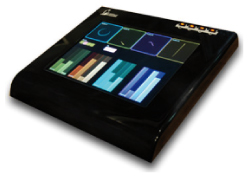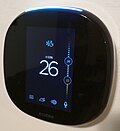Touchscreen
A touchscreen is a computer screen that can be used by touching it with a finger or a stylus pen, instead of using a mouse or remote control. It can be described as a touchpad with a screen built-in to it.
Today, all kinds of devices, both big and small, use touchscreens. However, tablet computers and smartphones have made them popular and are the most widely known and used products that use touchscreens.
History
In 1965, E.A Johnson of England’s Royal Radar Establishment, invented[1] the first touchscreen that was used in the U.K for air traffic control up until around 1995. The first resistive touch screen was invented by G. Samuel Hurst in 1975, and produced in 1982. Back in 1970, Hurst and nine friends discovered that a touchscreen on a computer monitor made for an excellent method of interaction. Pressure on the cover sheet allowed voltage to flow between the X wires and the Y wires, which could be measured to indicate coordinates. This discovery helped found what we today refer to as resistive touch technology (because it responds purely to pressure rather than electrical conductivity, working with both a stylus and a finger).
Much later in 2005, three friends from France created a multi-touch screen capable of tracking any numbers of fingers. By 2005, their company named JazzMutant released the Lemur, a music controller with a multi-touch screen interface. This new technology helped influenced the TactaPad also made in 2005. Two years later, in January 2007, the iPhone was released, which was controlled entirely by a multi-touch screen.[2] It and the iPad, which came out in September 2010, were very successful and would eventually lead to more companies adding touchscreens to their products. They included Samsung, Sony, Motorola, and many companies who adopted the touch-friendly Android operating system.[3][4]
In response to the popularity of touchscreens, Microsoft, maker of the Windows family of operating systems for personal computers, would introduce a new interface in Windows 8 in 2011, which has large tiles that are meant to be used with touch technology, like tablets.[5] It would come out the next year, along with the Microsoft Surface tablet.[6]
Usage
Because of how easy they are to use, touchscreens can be found in many places. Along with general computing and consumer electronics devices such as smartphones, tablets, smartwatches and personal computers, touchscreens are also widely used on kiosks, which are used for information systems in cities and museums. They are also found on machines including Automatic Teller Machines (ATMs), cash registers and retail point-of-sale terminals, GPS navigation systems such as those in cars and other vehicles, medical equipment and industrial control panels. The touchscreen built into kiosks use simple point and click interaction. Interactive whiteboards, which can be found in many schools, also use a simple form of touch technology.
Types
Different kinds of touchscreens work in different ways. There are two main technologies used for touchscreens:
- A resistive touchscreen has a layer of conducting polyester plastic. When you press on it, you force the polyester to touch the glass and complete an electric circuit. A chip under the screen identifies the coordinates of the place you touched. These screens can sense only one finger at a time and get confused if you try to press in two places at once. They are often used in industrial equipment because it is strong and responds to any kind of input, such as when wearing gloves.
- A capacitive touchscreen has multiple layers of glass. Both the innermost and outermost layers of glass conduct electricity. The screen behaves like two electrical conductors separated by an insulator—in other words, a capacitor. Unlike resistive screens, capacitive screens can easily detect and distinguish more than one press at once. This is called multi-touch.
Unlike resistive screens, capacitive screens do not work if you touch them with a plastic stylus because the plastic acts as an insulator. Some stylus pens, such as the Apple Pencil for the iPad Pro, are made to work with capacitive screens. They are pressure sensitive and let you to do different things by pushing harder or more gently. For example, you can draw a wider or narrower line in programs like Microsoft OneNote and Adobe Photoshop.
Touchscreen Media
Smart thermostat with touchscreen
The prototype x-y mutual capacitance touchscreen (left) developed at CERN in 1977 by Frank Beck, a British electronics engineer, for the control room of CERN's accelerator SPS (Super Proton Synchrotron). This was a further development of the self-capacitance screen (right), also developed by Stumpe at CERN in 1972.
Printed circuit board from a control panel of a device using an infrared touchscreen, showing the arrays of infrared LEDs and photodiodes used to detect touches
Fingerprints and smudges on an iPad (tablet computer) touchscreen
References
- ↑ "What's the History of Touch Screen Technology?". ThoughtCo. Retrieved 2024-02-18.
- ↑ "iPhone Touch Screen - How it Works". How Stuff Works. 2015. Archived from the original on May 21, 2015. Retrieved May 21, 2015.
- ↑ Nicole Cohen (26 December 2011). "Timeline: A Histoty of Touch Screen Technology". NPR. Disqus. Retrieved May 21, 2015.
- ↑ "The Past, Present, and Future of Touch". Conde Nast. 2015. Retrieved May 7, 2015.
- ↑ Ferguson, Tim (2011-06-02). "Windows 8 revealed: Microsoft goes tablets and tiles with next OS" (in en). ZDNet. http://www.zdnet.com/article/windows-8-revealed-microsoft-goes-tablets-and-tiles-with-next-os/. Retrieved 2018-03-16.
- ↑ Halliday, Josh (2012-10-25). "Microsoft Windows 8 launch and Surface event – as it happened". the Guardian. Retrieved 2018-03-16.









